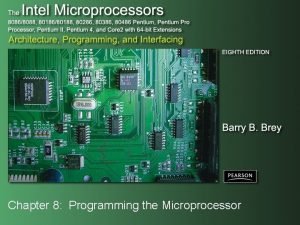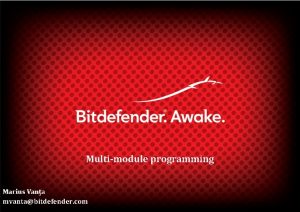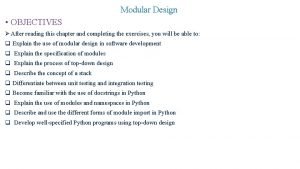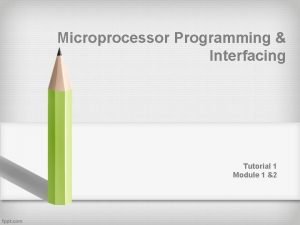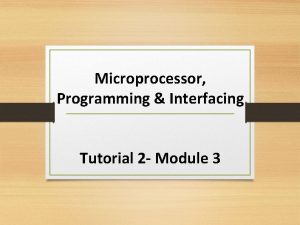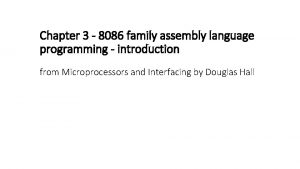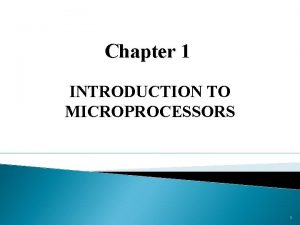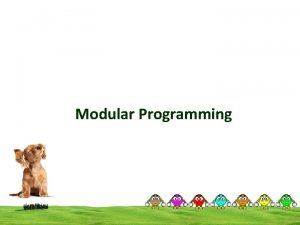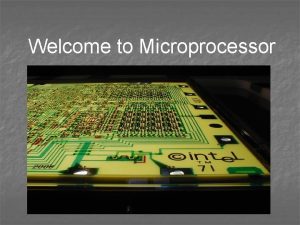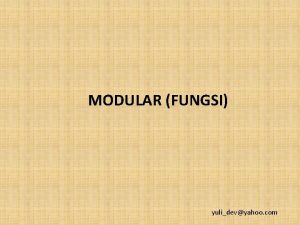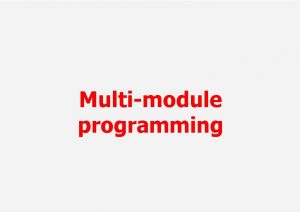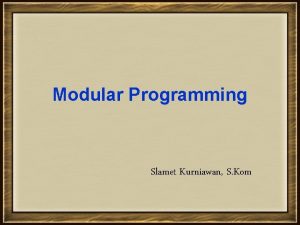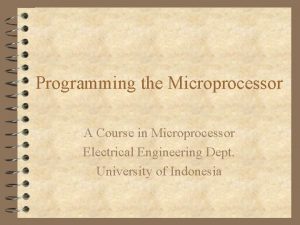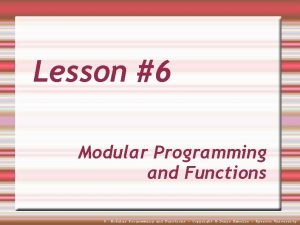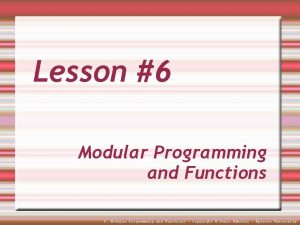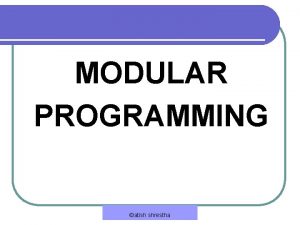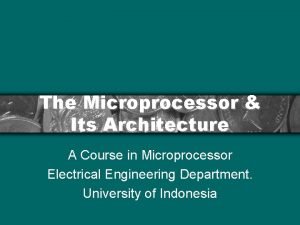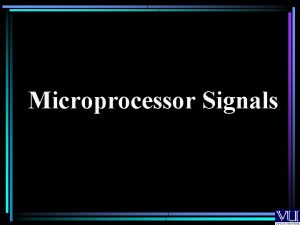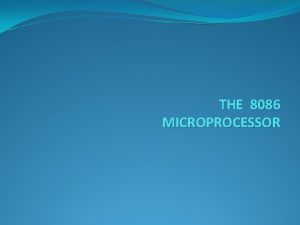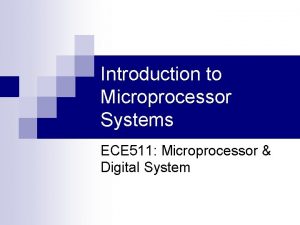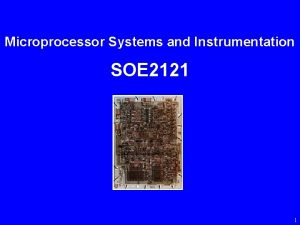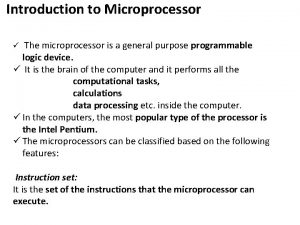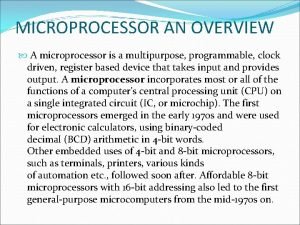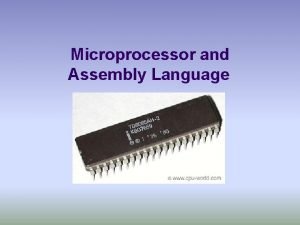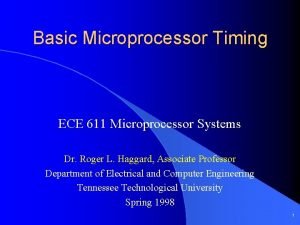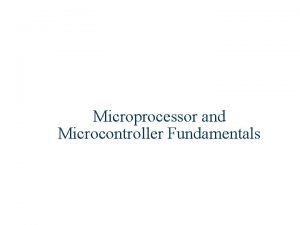Chapter 8 Programming the Microprocessor 8 1 MODULAR
























- Slides: 24

Chapter 8: Programming the Microprocessor

8– 1 MODULAR PROGRAMMING • Many programs are too large to be developed by one person. – programs are routinely developed by teams of programmers • The linker program is provided with Visual Studio so that programming modules can be linked together into a complete program. • Linking is also available from the command prompt provided by Windows. The Intel Microprocessors: 8086/8088, 80186/80188, 80286, 80386, 80486 Pentium, Pentium Processor, Pentium II, Pentium, 4, and Core 2 with 64 -bit Extensions Architecture, Programming, and Interfacing, Eighth Edition Barry B. Brey Copyright © 2009 by Pearson Education, Inc. Upper Saddle River, New Jersey 07458 • All rights reserved.

The Assembler and Linker • The assembler program converts a symbolic source module (file) into a hexadecimal object file. • It is even a part of Visual Studio, located in the C: Program FilesMicrosoft Visual Studio. NET 2003Vc 7bin folder. • The version that comes with Visual C will not work for 16 -bit DOS programs. – if a 16 -bit assembler and linker are needed, they are in the Windows Driver Development Kit (DDK) The Intel Microprocessors: 8086/8088, 80186/80188, 80286, 80386, 80486 Pentium, Pentium Processor, Pentium II, Pentium, 4, and Core 2 with 64 -bit Extensions Architecture, Programming, and Interfacing, Eighth Edition Barry B. Brey Copyright © 2009 by Pearson Education, Inc. Upper Saddle River, New Jersey 07458 • All rights reserved.

• Whenever you create a source file, it should have the extension of ASM. • Source files are created by using Note. Pad or almost any other word processor or editor capable of generating an ASCII file. • The linker program, which executes as the second part of ML, reads the object files that are created by the assembler program and links them together into a single execution file. • An execution file is created with the file name extension EXE. The Intel Microprocessors: 8086/8088, 80186/80188, 80286, 80386, 80486 Pentium, Pentium Processor, Pentium II, Pentium, 4, and Core 2 with 64 -bit Extensions Architecture, Programming, and Interfacing, Eighth Edition Barry B. Brey Copyright © 2009 by Pearson Education, Inc. Upper Saddle River, New Jersey 07458 • All rights reserved.

The Intel Microprocessors: 8086/8088, 80186/80188, 80286, 80386, 80486 Pentium, Pentium Processor, Pentium II, Pentium, 4, and Core 2 with 64 -bit Extensions Architecture, Programming, and Interfacing, Eighth Edition Barry B. Brey Copyright © 2009 by Pearson Education, Inc. Upper Saddle River, New Jersey 07458 • All rights reserved.

The Intel Microprocessors: 8086/8088, 80186/80188, 80286, 80386, 80486 Pentium, Pentium Processor, Pentium II, Pentium, 4, and Core 2 with 64 -bit Extensions Architecture, Programming, and Interfacing, Eighth Edition Barry B. Brey Copyright © 2009 by Pearson Education, Inc. Upper Saddle River, New Jersey 07458 • All rights reserved.

• Execution files are selected by typing the file name at the DOS prompt (C: ). • If a file is short enough (less than 64 K bytes long), it can be converted from an execution file to a command file (. COM). • The command file is slightly different from an execution file in that the program must be originated at location 0100 H before it can execute. • This means that the program must be no larger than 64 K– 100 H in length. The Intel Microprocessors: 8086/8088, 80186/80188, 80286, 80386, 80486 Pentium, Pentium Processor, Pentium II, Pentium, 4, and Core 2 with 64 -bit Extensions Architecture, Programming, and Interfacing, Eighth Edition Barry B. Brey Copyright © 2009 by Pearson Education, Inc. Upper Saddle River, New Jersey 07458 • All rights reserved.

• Library files are entered after the file name and after the switch / LINK. • To use a library called NUMB. LIB while assembling a program called NEW. ASM, type ML NEW. ASM / LINK NUMB. LIB • In the Windows environment you cannot link a program—only assemble program. • You must use Visual Studio to link the program files during the build. • You can assemble a file or files and generate objects for use with Visual C++. The Intel Microprocessors: 8086/8088, 80186/80188, 80286, 80386, 80486 Pentium, Pentium Processor, Pentium II, Pentium, 4, and Core 2 with 64 -bit Extensions Architecture, Programming, and Interfacing, Eighth Edition Barry B. Brey Copyright © 2009 by Pearson Education, Inc. Upper Saddle River, New Jersey 07458 • All rights reserved.

To use a library called NUMB. LIB type C: masm 614BINml new. asm /LINK NUMB. LIB The Intel Microprocessors: 8086/8088, 80186/80188, 80286, 80386, 80486 Pentium, Pentium Processor, Pentium II, Pentium, 4, and Core 2 with 64 -bit Extensions Architecture, Programming, and Interfacing, Eighth Edition Barry B. Brey Copyright © 2009 by Pearson Education, Inc. Upper Saddle River, New Jersey 07458 • All rights reserved.

Public and Extern • Very important to modular programming as they allow communications between modules. – PUBLIC declares labels of code, data, or entire segments are available to other program modules – EXTRN (external) declares labels are external to a module • Without these statements, modules could not be linked together to create a program by using modular programming techniques. – modules would communicate with one another The Intel Microprocessors: 8086/8088, 80186/80188, 80286, 80386, 80486 Pentium, Pentium Processor, Pentium II, Pentium, 4, and Core 2 with 64 -bit Extensions Architecture, Programming, and Interfacing, Eighth Edition Barry B. Brey Copyright © 2009 by Pearson Education, Inc. Upper Saddle River, New Jersey 07458 • All rights reserved.

The Intel Microprocessors: 8086/8088, 80186/80188, 80286, 80386, 80486 Pentium, Pentium Processor, Pentium II, Pentium, 4, and Core 2 with 64 -bit Extensions Architecture, Programming, and Interfacing, Eighth Edition Barry B. Brey Copyright © 2009 by Pearson Education, Inc. Upper Saddle River, New Jersey 07458 • All rights reserved.

• PUBLIC is placed in the opcode field of a statement to define a label as public, so the label can be seen & used by other modules. – made public, they combine with other public segments containing data with the same name • EXTRN appears in both data and code segments to define labels as external to the segment. – if defined as external, sizes must be defined as BYTE, WORD, or DWORD – if jump or call address is external, it must be defined as NEAR or FAR The Intel Microprocessors: 8086/8088, 80186/80188, 80286, 80386, 80486 Pentium, Pentium Processor, Pentium II, Pentium, 4, and Core 2 with 64 -bit Extensions Architecture, Programming, and Interfacing, Eighth Edition Barry B. Brey Copyright © 2009 by Pearson Education, Inc. Upper Saddle River, New Jersey 07458 • All rights reserved.

The Intel Microprocessors: 8086/8088, 80186/80188, 80286, 80386, 80486 Pentium, Pentium Processor, Pentium II, Pentium, 4, and Core 2 with 64 -bit Extensions Architecture, Programming, and Interfacing, Eighth Edition Barry B. Brey Copyright © 2009 by Pearson Education, Inc. Upper Saddle River, New Jersey 07458 • All rights reserved.

Libraries • Libraries allow common procedures to be collected into one place so they can be used by many different applications. – assembled and compiled by the LIB program that accompanies the MASM assembler • When the library file is linked with a program, only procedures required by are removed from the library file and added to the program. • A good set of library files is essential and saves hours in recoding common functions. The Intel Microprocessors: 8086/8088, 80186/80188, 80286, 80386, 80486 Pentium, Pentium Processor, Pentium II, Pentium, 4, and Core 2 with 64 -bit Extensions Architecture, Programming, and Interfacing, Eighth Edition Barry B. Brey Copyright © 2009 by Pearson Education, Inc. Upper Saddle River, New Jersey 07458 • All rights reserved.

Creating a Library File • A library file is a collection of assembled. OBJ files that contains procedures or tasks written in assembly language or any other language. • The procedure must be declared PUBLIC and does not need to match the file name. • A variable is transferred to each file, so the EXTRN statement also appears in each procedure to gain access to an external variable. The Intel Microprocessors: 8086/8088, 80186/80188, 80286, 80386, 80486 Pentium, Pentium Processor, Pentium II, Pentium, 4, and Core 2 with 64 -bit Extensions Architecture, Programming, and Interfacing, Eighth Edition Barry B. Brey Copyright © 2009 by Pearson Education, Inc. Upper Saddle River, New Jersey 07458 • All rights reserved.

• The LIB program begins with the copyright message from Microsoft, followed by the prompt Library name. • Because this is a new file, the library program must be prompted with the object file name. • The LIB program is invoked with the object name following it on the command line. • Once a library file is linked to your program, only the library procedures actually used by your program are placed in the execution file. The Intel Microprocessors: 8086/8088, 80186/80188, 80286, 80386, 80486 Pentium, Pentium Processor, Pentium II, Pentium, 4, and Core 2 with 64 -bit Extensions Architecture, Programming, and Interfacing, Eighth Edition Barry B. Brey Copyright © 2009 by Pearson Education, Inc. Upper Saddle River, New Jersey 07458 • All rights reserved.

Macros • A group of instructions that perform one task, just as a procedure performs one task. – a procedure is accessed via a CALL instruction – a macro & all instructions defined in the macro, is inserted in the program at the point of usage • Creating a macro is very similar to creating a new opcode • Macros execute faster than procedures because there is no CALL or RET instruction to execute. The Intel Microprocessors: 8086/8088, 80186/80188, 80286, 80386, 80486 Pentium, Pentium Processor, Pentium II, Pentium, 4, and Core 2 with 64 -bit Extensions Architecture, Programming, and Interfacing, Eighth Edition Barry B. Brey Copyright © 2009 by Pearson Education, Inc. Upper Saddle River, New Jersey 07458 • All rights reserved.

• Macros will not function with the inline assembler – only in external assembly language modules • MACRO and ENDM directives delineate a macro sequence. – MACRO contains the name of the macro and any parameters associated with it • Last statement of a macro is the ENDM instruction, which is placed on a line by itself. • Never place a label in front of ENDM, – the macro will not assemble The Intel Microprocessors: 8086/8088, 80186/80188, 80286, 80386, 80486 Pentium, Pentium Processor, Pentium II, Pentium, 4, and Core 2 with 64 -bit Extensions Architecture, Programming, and Interfacing, Eighth Edition Barry B. Brey Copyright © 2009 by Pearson Education, Inc. Upper Saddle River, New Jersey 07458 • All rights reserved.

Local Variables in a Macro • A local variable is one that appears in the macro, but is not available outside the macro. – to define use the LOCAL directive • The LOCAL directive must always be used on the line immediately following the MACRO statement or an error occurs. • The LOCAL statement may have up to 35 labels, all separated with commas. The Intel Microprocessors: 8086/8088, 80186/80188, 80286, 80386, 80486 Pentium, Pentium Processor, Pentium II, Pentium, 4, and Core 2 with 64 -bit Extensions Architecture, Programming, and Interfacing, Eighth Edition Barry B. Brey Copyright © 2009 by Pearson Education, Inc. Upper Saddle River, New Jersey 07458 • All rights reserved.

Placing MACRO Definitions in Their Own Module • Macro definitions can be placed in the program file or in their own macro module. – a file can be created that contains only macros to be included with other program files • Use the INCLUDE directive to indicate a program file will include a module that contains external macro definitions. • While not a library file, for practical purposes it functions as a library of macro sequences. The Intel Microprocessors: 8086/8088, 80186/80188, 80286, 80386, 80486 Pentium, Pentium Processor, Pentium II, Pentium, 4, and Core 2 with 64 -bit Extensions Architecture, Programming, and Interfacing, Eighth Edition Barry B. Brey Copyright © 2009 by Pearson Education, Inc. Upper Saddle River, New Jersey 07458 • All rights reserved.

• When macro sequences are placed in a file they do not contain PUBLIC statements as does a library. • Programs may contain both macro include files and library files. • A macro file named MACRO. MAC included in an assembly file using the statement: INCLUDE C: ASSMMACRO. MAC • No public or extern directives are needed to access macro statements that have been included. The Intel Microprocessors: 8086/8088, 80186/80188, 80286, 80386, 80486 Pentium, Pentium Processor, Pentium II, Pentium, 4, and Core 2 with 64 -bit Extensions Architecture, Programming, and Interfacing, Eighth Edition Barry B. Brey Copyright © 2009 by Pearson Education, Inc. Upper Saddle River, New Jersey 07458 • All rights reserved.

The Intel Microprocessors: 8086/8088, 80186/80188, 80286, 80386, 80486 Pentium, Pentium Processor, Pentium II, Pentium, 4, and Core 2 with 64 -bit Extensions Architecture, Programming, and Interfacing, Eighth Edition Barry B. Brey Copyright © 2009 by Pearson Education, Inc. Upper Saddle River, New Jersey 07458 • All rights reserved.

The Intel Microprocessors: 8086/8088, 80186/80188, 80286, 80386, 80486 Pentium, Pentium Processor, Pentium II, Pentium, 4, and Core 2 with 64 -bit Extensions Architecture, Programming, and Interfacing, Eighth Edition Barry B. Brey Copyright © 2009 by Pearson Education, Inc. Upper Saddle River, New Jersey 07458 • All rights reserved.

The Intel Microprocessors: 8086/8088, 80186/80188, 80286, 80386, 80486 Pentium, Pentium Processor, Pentium II, Pentium, 4, and Core 2 with 64 -bit Extensions Architecture, Programming, and Interfacing, Eighth Edition Barry B. Brey Copyright © 2009 by Pearson Education, Inc. Upper Saddle River, New Jersey 07458 • All rights reserved.
 What is modular programming in microprocessor
What is modular programming in microprocessor Modular programming
Modular programming Top down modular design
Top down modular design Objectives of modular software design
Objectives of modular software design Microprocessor programming tutorial
Microprocessor programming tutorial Microprocessor programming tutorial
Microprocessor programming tutorial Microprocessor programming tutorial
Microprocessor programming tutorial 8086 program development steps
8086 program development steps Perbedaan linear programming dan integer programming
Perbedaan linear programming dan integer programming Greedy programming vs dynamic programming
Greedy programming vs dynamic programming System programming
System programming Linear vs integer programming
Linear vs integer programming Perbedaan linear programming dan integer programming
Perbedaan linear programming dan integer programming Microprocessor chapter 1
Microprocessor chapter 1 Hình ảnh bộ gõ cơ thể búng tay
Hình ảnh bộ gõ cơ thể búng tay Frameset trong html5
Frameset trong html5 Bổ thể
Bổ thể Tỉ lệ cơ thể trẻ em
Tỉ lệ cơ thể trẻ em Gấu đi như thế nào
Gấu đi như thế nào Thang điểm glasgow
Thang điểm glasgow Hát lên người ơi
Hát lên người ơi Môn thể thao bắt đầu bằng chữ đua
Môn thể thao bắt đầu bằng chữ đua Thế nào là hệ số cao nhất
Thế nào là hệ số cao nhất Các châu lục và đại dương trên thế giới
Các châu lục và đại dương trên thế giới Cong thức tính động năng
Cong thức tính động năng
